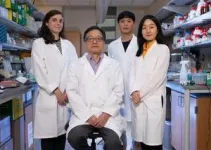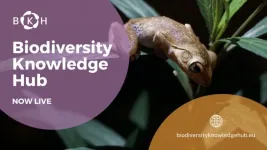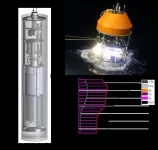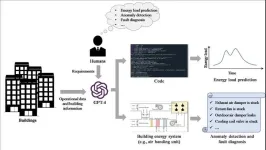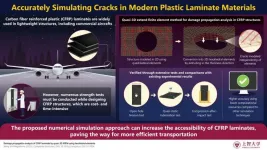(Press-News.org) LA JOLLA, CALIF. – July 18, 2023 –Research from Sanford Burnham Prebys and the Osaka International Cancer Institute has shed new light on the anti-cancer properties of mannose, a sugar that is crucial to many physiological processes in humans and is also known to inhibit the growth of cancer cells. The findings, published in the journal eLife, suggest that mannose could be a helpful secondary treatment for cancer.
“This sugar could give cancer an extra punch alongside other treatments,” says study co-author Hudson Freeze, Ph.D., director of the Human Genetics Program at Sanford Burnham Prebys. “And because mannose is found throughout the body naturally, it could improve cancer treatment without any undesirable side effects.”
Mannose is a sugar that the body adds to proteins to stabilize their structure and help them interact with other molecules. This process, called glycosylation, is essential for life; and malfunctions in glycosylation are associated with rare, but often life-threatening, human diseases.
“Until now, the most promising therapeutic use for mannose was to treat congenital disorders of glycosylation, diseases that can cause a wide range of severe symptoms throughout the body,” says Freeze. “But we believe that there may be ways to leverage mannose against cancer and other diseases as well.”
Mannose has already been shown to inhibit the growth of several types of cancer in the lab, but scientists don’t fully understand why this happens. To learn more, the research team turned their attention to an unusual property of mannose observed in an unlikely subject: honeybees.
“It’s been known for more than a century that mannose is lethal to honeybees because they can’t process it like humans do—it’s known as ‘honeybee syndrome,’” says Freeze. “We wanted to see if there is any relationship between honeybee syndrome and the anti-cancer properties of mannose, which could lead to an entirely new approach to combat cancer.”
Using genetically engineered human cancer cells from fibrosarcoma—a rare cancer that affects connective tissue—the research team re-created honeybee syndrome and discovered that without the enzyme needed to metabolize mannose, cells replicate slowly and are significantly more vulnerable to chemotherapy.
“We found that triggering honeybee syndrome in these cancer cells made them unable to synthesize the building blocks of DNA and replicate normally,” says Freeze. “This helps explain the anti-cancer effects of mannose that have we’ve observed in the lab.”
While leveraging honeybee syndrome could be a promising supplemental cancer treatment, the researchers caution that because the effect is dependent on vital metabolic processes, more research is needed to determine which types of cancer would be most vulnerable to mannose.
“If we can find cancers that have a low activity of the enzyme that processes mannose, treating them with mannose could give just enough of a nudge to make chemotherapy more effective,” says Freeze. “Many people assume that you always discover treatments in response to the disease, but sometimes you find biology that could be useful for treatment and then have to find the disease to match it.”
In the meantime, the study speaks to the broader potential of glycosylating sugars for cancer treatment, which is still an emerging area of research.
“The glycobiology of sugar metabolism within cancer cells is still an unexplored frontier, and it could be an untapped treasure trove of potential treatments just waiting to be discovered,” adds Freeze.
###
Additional authors on the study include Yoichiro Harada, Yu Mizote, Toru Hiratsuka, Yusuke Imagawa, Kento Maeda, Yuki Ohkawa, Shigeki Higashiyama, Hideaki Tahara and Naoyuki Taniguchi, Osaka International Cancer Institute; Takehiro Suzuki and Naoshi Dohmae, RIKEN Center for Sustainable Resource Science; Akiyoshi Hirayama, Satsuki Ikeda and Junko Murai, Keio University; Mikako Nishida and Heiichiro Udono, Okayama University Graduate School of Medicine, Dentistry and Pharmaceutical Sciences; and Ayaka Ueda and Eiji Miyoshi, Osaka University.
The study was supported by the Takeda Science Foundation, JSPS KAKENHI (JP23K06645), the Rocket Fund, and the National Institutes of Health (R01DK99551).
The study’s DOI is 10.7554/eLife.83870.
About Sanford Burnham Prebys
Sanford Burnham Prebys is an independent biomedical research institute dedicated to understanding human biology and disease and advancing scientific discoveries to profoundly impact human health. For more than 45 years, our research has produced breakthroughs in cancer, neuroscience, immunology and children’s diseases, and is anchored by our NCI-designated Cancer Center and advanced drug discovery capabilities. For more information, visit us at SBPdiscovery.org or on Facebook facebook.com/SBPdiscovery and on Twitter @SBPdiscovery.
END
This sugar kills honeybees—it could also help fight cancer
A new study helps explain the anti-cancer properties of mannose sugar
2023-07-18
ELSE PRESS RELEASES FROM THIS DATE:
Smiles all round: clinical trial shows that a toothpaste containing synthetic tooth minerals can prevent cavities as effectively as fluoride
2023-07-18
Brushing twice a day keeps the dentist away – but can we improve on the toothpaste we use to maintain clean teeth, preventing medical issues that spiral from poor dental health? Most toothpastes use fluoride, a powerful tool for oral hygiene. However, fluoride can pose health problems in some cases, especially for children who consume too much fluoride by swallowing most of their toothpaste: children normally use only a tiny dose of toothpaste to avoid these problems, but that reduces toothbrushing efficacy. In the search for alternatives, a team of international scientists and Polish clinicians have identified a hydroxyapatite toothpaste that works just as well as fluoride toothpaste ...
A new way to browse interlinked biodiversity data: The Biodiversity Knowledge Hub is now online!
2023-07-18
The Horizon 2020 BiCIKL Project is proud to announce that the Biodiversity Knowledge Hub (BKH) is now online.
BKH is a one-stop portal that allows users to access FAIR and interlinked biodiversity data and services in a few clicks. BKH was designed to support a new emerging community of users over time and across the entire biodiversity research cycle providing its services to anybody, anywhere and anytime.
“The Knowledge Hub is the main product from our BiCIKL consortium, and we are delighted with the result! BKH can easily be seen as the beginning of the major shift in the way we search interlinked biodiversity information,”
says Prof. Lyubomir ...
The double face of RNase as a treatment for systemic autoimmune diseases
2023-07-18
Osaka, Japan – Systemic autoimmune diseases are characterized by inflammation of multiple organs and can have devastating consequences for patients. There is a dire need for treatments against these diseases. RNase treatments seem promising in some clinical trials but not all. Researchers from Japan have uncovered the reasons for this variability.
In a study recently published in the Journal of Clinical Investigation Insight (JCI Insight), researchers from Osaka University have provided new insights into the opposite effects of RNase ...
Unveiling synchronization preferences of quantum thermal machines
2023-07-18
Researchers from the Center of Theoretical Physics of Complex Systems within the Institute for Basic Science (PCS-IBS) made an important discovery that describes the relationship between synchronization and thermodynamics in quantum systems.
The question of how order arises from disorder has captivated humanity for centuries. One fascinating example of such emergence is synchronization, where multiple oscillators initialized randomly could end up oscillating in harmony. Synchronization exists in our everyday lives, e.g. the sound of clapping hands or the simultaneous flashing of fireflies. Remarkably, scientists have discovered ...
Prof. Chilai Chen’s team developed the first deep-sea mass spectrometer of China and successfully tested at deep sea
2023-07-18
The study is led by Prof. Chilai Chen (Hefei Institutes of Physical Science, Chinese Academy of Sciences).
The detection of dissolved gases in the deep sea is of great significance in exploring the origin and early evolution of life, understanding the interaction between the Earth's spheres, studying the geological profile of the Earth, searching for underwater oil, gas, and mineral resources, and researching global climate change. Changes in the concentrations of dissolved oxygen and nitrogen can indirectly or directly reflect the activity patterns ...
Unlocking human-level capabilities: GPT-4 empowers data mining for building energy management
2023-07-18
The building sector is a significant contributor to global energy consumption, accounting for approximately 33% of the world's final energy usage. Recently, data mining technologies have showed powerful capacities for revealing energy waste and providing energy-saving tips to building owners. These technologies have the ability to save approximately 15%-30% of the energy consumed in buildings. However, the practical application of data mining technologies has been limited due to its labor-intensive nature, resulting in a scarcity of real-world use cases.
In a study published in the KeAi journal Energy and Built Environment, ...
New genes implicated in deadly heart defect
2023-07-18
LA JOLLA, CALIF. – July 17, 2023 – By identifying genes in patients and testing their effects in fruit flies, researchers from Sanford Burnham Prebys have found new genes that contribute to hypoplastic left heart syndrome (HLHS), a rare, life-threatening heart disease that occurs in infants. The findings, published in the journal eLife, bring scientists one step closer to unraveling the biology of this complex disease.
“Every case of HLHS is unique because there are many different things that can go wrong during the early development of the heart,” ...
Simulating damage propagation in composite materials through a novel computational method to realize high-quality CFRPs
2023-07-18
Structural materials with useful mechanical properties have applications in a diverse range of fields. A reliable way to enhance the properties of structural materials is to make them lighter without compromising their strength. Carbon fiber reinforced plastics (CFRPs) are perhaps the most prominent example of this approach. These plastics are made up of tiny, yet extremely strong threads of carbon atoms held together by a plastic matrix. Owing to their low weight, high durability, and exceptional mechanical performance, CFRP laminates are being incorporated into state-of-the-art ...
Analysis: Most research on PFAS harms is unpublicized
2023-07-18
Though per- and polyfluoroalkyl substances (PFAS) make headlines daily, a new paper reveals that most studies finding links between PFAS exposure and human health harms are published without a press release and receive little or no media coverage. The peer-reviewed analysis, published today in the journal Environmental Health, found that studies without any press attention receive fewer scholarly citations as well.
“It’s a shame that only a small slice of this science is reaching the public,” ...
As interest rates soar, new study reveals insecure workers are ‘trapped’ and 42% fear job losses
2023-07-18
Researchers from the Work Foundation at Lancaster University say the notion that people are choosing to stay in insecure work for the ‘perk’ of flexibility is flawed – as almost half (46%) would find another job if given the chance.
However, they feel trapped due to limiting factors such as the cost and availability of childcare and transport, as well as a lack of local job opportunities.
With persistent inflation, rising interest rates and the cost of food on the rise, the think-tank warns that millions of insecure workers in the UK are most vulnerable due to the volatility in their pay, working hours and a lack of core protections like sick and redundancy ...
LAST 30 PRESS RELEASES:
How the parasite that ‘gave up sex’ found more hosts – and why its victory won’t last
When is it time to jump? The boiling frog problem of AI use in physics education
Twitter data reveals partisan divide in understanding why pollen season's getting worse
AI is quick but risky for updating old software
Revolutionizing biosecurity: new multi-omics framework to transform invasive species management
From ancient herb to modern medicine: new review unveils the multi-targeted healing potential of Borago officinalis
Building a global scientific community: Biological Diversity Journal announces dual recruitment of Editorial Board and Youth Editorial Board members
Microbes that break down antibiotics help protect ecosystems under drug pollution
Smart biochar that remembers pollutants offers a new way to clean water and recycle biomass
Rice genes matter more than domestication in shaping plant microbiomes
Ticking time bomb: Some farmers report as many as 70 tick encounters over a 6-month period
Turning garden and crop waste into plastics
Scientists discover ‘platypus galaxies’ in the early universe
Seeing thyroid cancer in a new light: when AI meets label-free imaging in the operating room
Neutrophil-to-lymphocyte ratio may aid risk stratification in depressive disorder
2026 Seismological Society of America Annual Meeting
AI-powered ECG analysis offers promising path for early detection of chronic obstructive pulmonary disease, says Mount Sinai researchers
GIMM uncovers flaws in lab-grown heart cells and paves the way for improved treatments
Cracking the evolutionary code of sleep
Medications could help the aging brain cope with surgery, memory impairment
Back pain linked to worse sleep years later in men over 65, according to study
CDC urges ‘shared decision-making’ on some childhood vaccines; many unclear about what that means
New research finds that an ‘equal treatment’ approach to economic opportunity advertising can backfire
Researchers create shape-shifting, self-navigating microparticles
Science army mobilizes to map US soil microbiome
Researchers develop new tools to turn grain crops into biosensors
Do supervised consumption sites bring increased crime? Study suggests that’s a myth
New mass spec innovation could transform research
Maternal nativity, race, and ethnicity and infant mortality in the US
Migration-related trauma among asylum seekers exposed to the migrant protection protocols
[Press-News.org] This sugar kills honeybees—it could also help fight cancerA new study helps explain the anti-cancer properties of mannose sugar

